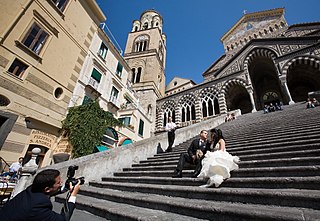
From the earliest days of the Christian faith, Christians have viewed marriage as a divinely blessed, lifelong, monogamous union between a man and a woman. However, while many Christians might agree with the traditional definition, the terminology and theological views of marriage have varied through time in different countries, and among Christian denominations.

Irenaeus was a Greek bishop noted for his role in guiding and expanding Christian communities in the southern regions of present-day France and, more widely, for the development of Christian theology by combating heterodox or Gnostic interpretations of Scripture as heresy and defining proto-orthodoxy. Originating from Smyrna, he had seen and heard the preaching of Polycarp, who in turn was said to have heard John the Evangelist, and thus was the last-known living connection with the Apostles.

Polycarp was a Christian bishop of Smyrna. According to the Martyrdom of Polycarp, he died a martyr, bound and burned at the stake, then stabbed when the fire failed to consume his body. Polycarp is regarded as a saint and Church Father in the Catholic Church, Eastern Orthodox Church, Oriental Orthodox Churches, Lutheranism, and Anglicanism.

The phrase "What would Jesus do?", often abbreviated to WWJD, became popular particularly in the United States in the early 1900s after the widely read book In His Steps: What Would Jesus Do? by Charles Sheldon. The phrase had a resurgence in the 1990s as a personal motto for adherents of Christianity, who used it as a reminder of their belief in a moral imperative to act in a manner demonstrating the love of Jesus through their actions. The resurgence of the motto during the 1990s stems from the W.W.J.D. abbreviation on wristbands that became popular among Christian youth groups.

The United Holy Church of America, Inc. (UHCA) is the oldest African-American Holiness-Pentecostal body in the world. It was established in 1886. It is a predominantly black Pentecostal denomination, with the international headquarters is located at 5104 Dunstan Road in Greensboro, North Carolina. The UHCA consists of an estimated 516 churches, 17 districts, and 8 territories. The largest and the oldest district of the connectional body is the Southern District Convocation.
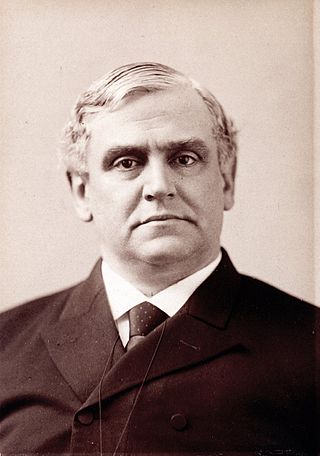
Phillips Brooks was an American Episcopal clergyman and author, long the Rector of Boston's Trinity Church and briefly Bishop of Massachusetts. He wrote the lyrics of the Christmas hymn, "O Little Town of Bethlehem".

Charles Monroe Sheldon was an American Congregationalist minister and a leader of the Social Gospel movement. His 1896 novel In His Steps introduced the principle "What would Jesus do?", which articulated an approach to Christian theology that became popular at the turn of the 20th century and enjoyed a revival almost one hundred years later. The stretch of US-24 on the north side of Topeka, Kansas, between US-75 and K-4 is named the "Charles Sheldon Trafficway" in his honor.

Henry Byron Warner was an English film and theatre actor. He was popular during the silent era and played Jesus Christ in The King of Kings. In later years, he successfully moved into supporting roles and appeared in numerous films directed by Frank Capra. Warner's most recognizable role to modern audiences is Mr. Gower in It's a Wonderful Life, directed by Capra. He appeared in the original 1937 version of Lost Horizon as Chang, for which he was nominated for the Academy Award for Best Supporting Actor.

The primacy of Peter, also known as Petrine primacy, is the position of preeminence that is attributed to Peter among the Twelve Apostles.
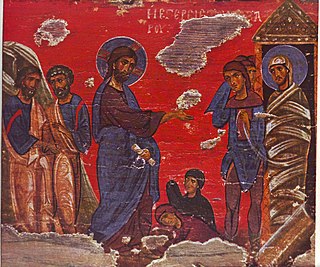
Lazarus of Bethany is a figure within the Christian Bible, mentioned in the New Testament in the Gospel of John, who four days after his death is restored to life by Jesus. This is seen by Christians as one of the miracles of Jesus. In the Eastern Orthodox Church, Lazarus is venerated as Righteous Lazarus, the Four-Days Dead. The Eastern Orthodox and Catholic traditions offer varying accounts of the later events of his life.

Colorado Territory is a 1949 American Western film noir directed by Raoul Walsh and starring Joel McCrea, Virginia Mayo, and Dorothy Malone. Written by Edmund H. North and John Twist, and based on the novel High Sierra by W.R. Burnett, the film is about an outlaw who is sprung from jail to help pull one last railroad job.
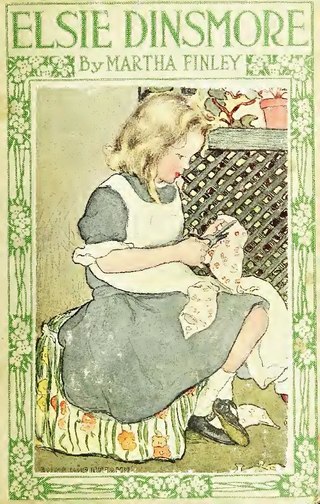
Elsie Dinsmore is a children's book series written by Martha Finley (1828–1909) between 1867 and 1905. Of Finley's two girls' fiction series, the "Mildred Keith" books were more realistic and autobiographical in nature, while the "Elsie Dinsmore" books, which were better sellers, were more idealistic in plot. A revised and adapted version of the Elsie books was published in 1999.

John Eleazer Remsburg was an ardent religious skeptic in America in the late 19th and early 20th centuries. In his book 1909 book The Christ, Remsburg lists forty-two ancient writers who did not mention Jesus or whose mentions are suspect, and this list has appeared in many subsequent books that question the historicity of Jesus. Remsburg himself wrote that the man Jesus may have existed, but that the Christ of the gospels is mythical.
Francis Gladden Bishop was a minor leader in the Latter Day Saint movement after the 1844 succession crisis. Bishop claimed to be the rightful successor to Joseph Smith; from the 1850s until his death, Bishop led a succession of small groups of Latter Day Saints and converts. His followings have been identified informally by later writers as the Gladdenites and the Church of Jesus Christ of Latter Day Saints (Gladdenite), though the name of a late following is formally The Church of Jesus Christ of the New Jerusalem. In the 1850s, many of Bishop's followers abandoned him and joined the movement that would later become the Church of Christ.
Arthur Graham Crowder Maxwell, often abbreviated as A. Graham Maxwell, was a Seventh-day Adventist theologian, and the emeritus professor of New Testament studies at Loma Linda University. In a 1985 survey of 55 religion teachers at North American Adventist colleges, Maxwell tied for fourth place among most influential Adventist authors.

Lorin Farr was a Mormon pioneer and the first mayor of Ogden, Utah.
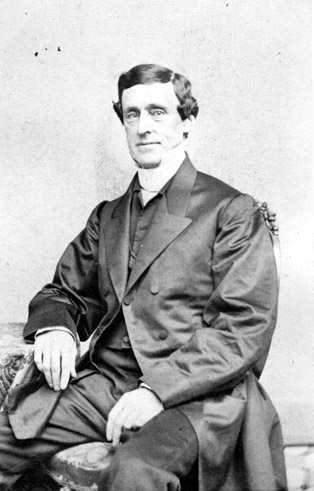
Henry John Whitehouse was the second Episcopal bishop of Illinois.
In the Church of Jesus Christ of Latter-day Saints, marriage between a man and a woman is considered to be "ordained of God". Marriage is thought to consist of a covenant between the man, the woman, and God. The church teaches that in addition to civil marriage, which ends at death, a man and woman can enter into a celestial marriage, performed in a temple by priesthood authority, whereby the marriage and parent–child relationships resulting from the marriage will last forever in the afterlife.
Henry Maxwell may refer to:















